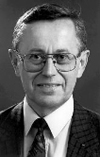About
In Memoriam: Indrek Martinson,
Nov 14, 2009
In Memoriam: Indrek Martinson, 1937-2009
 Indrek Martinson, an OSA Fellow who was a world-renowned expert in accelerator-based atomic physics, died unexpectedly on November 14, 2009. He was 71.
Indrek Martinson, an OSA Fellow who was a world-renowned expert in accelerator-based atomic physics, died unexpectedly on November 14, 2009. He was 71.
Martinson was an Emeritus Professor and Director of the Institute of Atomic Physics at the University of Lund, Sweden. He was also a former chair of the Physics Section of the Swedish Royal Academy of Sciences and an Adjunct Professor at the University of Toledo, Ohio, USA.
Martinson began his research as an assistant at the Nobel Institute of Physics in Stockholm, working under the directorship of Manne Siegbahn on beta- and gamma-ray spectroscopy. Interestingly, in a 1964 nuclear physics experiment, Martinson and a coworker set a lower limit to the lifetime of the proton that subsequently became a test of weak interaction theories. In 1968, Professor Ingmar Bergström, then director of the Nobel Institute, suggested that Martinson investigate the field of time-resolved fast ion beam atomic spectroscopy, which was being developed by Stanley Bashkin and William Bickel at the University of Arizona. An exchange program was arranged whereby Professor Bickel came to Stockholm, and Martinson spent a year working in the Tucson laboratory.
Martinson received his PhD from the University of Stockholm in 1971. In 1976 he was selected to occupy the Professorship at the University of Lund that had been vacated by the retirement of Bengt Edlén. As professor and director of the Atomic Physics Institute at Lund, Martinson brought about a merger of traditional high wavelength resolution metrology with fast ion beam time-resolved measurements, laser- and tokamak-produced plasma studies, synchrotron radiation measurements, and Fourier transform spectroscopy. He and his coworkers made pioneering measurements of doubly-excited states, developed quantum beat techniques that yielded unprecedented accuracies in lifetime and fine-structure measurements, devised ingenious methods for directly observing forbidden transition rates through differential lifetime measurements, and made measurements that have altered accepted elemental abundances in the sun and stars.
Martinson took a leading role in forging links between western scientists and their counterparts in Estonia, Lithuania, Russia, China, and Japan. He was a member of numerous international committees, including the Lithuanian and Estonian Academies of Science and the Advisory Board of the Japanese Institute of Physical and Chemical Research. 1991, Martinson was invited to return to the city of his birth to receive an Honorary Doctorate from the University of Tartu, Estonia.
An OSA member since 1969, Martinson was elected as a Fellow in 1979. He was also a Fellow of the American Physical Society (APS).
In addition to his abilities as a physicist, Martinson had an intense interest in and knowledge of music and sports, and was a highly ranked chess player. When international chess masters visited Stockholm, Martinson often entertained them, and was able to hold Bobby Fischer to a draw.
Martinson is survived by his wife Evi, 3 daughters and three grandchildren.
If you would like to make a donation to the OSA Foundation in memory of Indrek Martinson, please visit www.osa-foundation.org/give.
